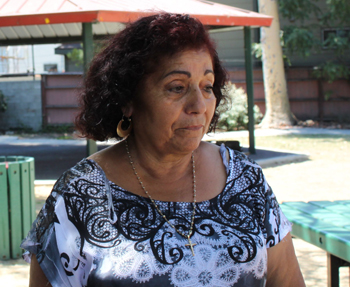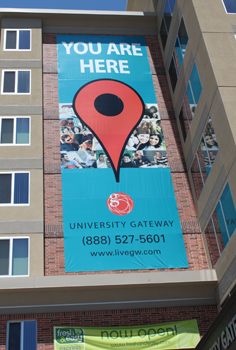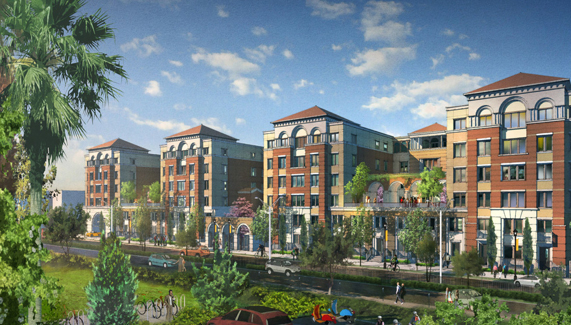Please make sure to read USC’s response to the issues raised by UNIDAD by clicking here.
Standing in the shade of a small pocket park sandwiched between modest apartments and the 110 Freeway,
 Juana Osorio is worried about getting pushed out of the neighborhood by the USC Master Plan. Juana Osorio is worried about getting pushed out of the neighborhood by the USC Master Plan. |
Juana Osorio spoke emphatically through an interpreter: “Me and my husband are on a very fixed income – we’re both already retired, so we depend on the support that my daughter and her husband living with us give us to share the rent.” Osorio is paying $1500 a month for a small house in the Estrella section of University Park, just north of USC.
The Osorios have lived in the neighborhood for almost forty years. They moved here after their previous, cheaper rental house a few streets over was sold. The new owners raised rents and the Osorios had to move.
Juana Osorio was one of the speakers on a recent journalists’ tour sponsored by United Neighbors in Defense Against Displacement (UNIDAD), a campaign launched by the Figueroa Corridor Coalition for Economic Justice, an alliance between affordable housing and activist groups. The alliance hopes to focus public attention on USC’s Master Expansion Plan, a 20-year agreement between USC and the City of Los Angeles, and its effects on the surrounding neighborhoods.
Many students, not enough housing
USC, which bills itself as the largest private employer in Los Angeles, has a total enrollment of 38,010 students. According to a 2012 study commissioned by Strategic Action for a Just Economy (SAJE) – a key member of UNIDAD – and authored by a Master’s degree candidate in USC’s School of Urban Planning, fully 71 percent of those students will not live in university-owned housing, even with additional units being built under the Master Plan.
USC currently offers 7,198 units of on-campus housing. The Master Plan, available online, says it will provide 7,600 new beds. However, the Environmental Impact Report (EIR) required by the city says that 5,200 beds will be built, but 1,200 existing beds will be lost.
The remaining students will have to live somewhere and many will fan out into the surrounding neighborhoods. These neighborhoods, which were fancy suburbs for early-20th century Angelenos, are now home to primarily low-income, working class Latinos and African Americans. The median income for the area is $18,533, making it one of the lowest-income areas in both the City and the County of Los Angeles, according to the L.A. Times’ “Mapping L.A.” project.
Beth Rodin, Director of Economic Development for Esperanza Community Housing Corporation, a UNIDAD member, said a majority of these residents pay one-third to one-half or more of their income on housing each month. And most of them live in rental housing.
Students and community compete for rentals
But with students looking to find rentals near campus, residents are often in direct competition for available housing. Scott Estevez, another speaker on the tour, is a 22-year-old whose family has lived in Esperanza affordable housing for almost eight years. He said that a friend of his father who owns rental housing in the neighborhood was told by a city housing inspector not to rent to Latinos, because they would ask for cheap rent and tear up the building, whereas students wouldn’t make a mess and would pay higher rents.
 And they often do pay higher rent. Privately-owned student housing can soar to $4,000/month, which is the case at the Gateway Housing development, located on the corner of Jefferson and Figueroa. Rents for a 2-bedroom apartment are $999 per person if the bedrooms are shared with another occupant. If the rooms are rented privately, the monthly rent is $1,798.
And they often do pay higher rent. Privately-owned student housing can soar to $4,000/month, which is the case at the Gateway Housing development, located on the corner of Jefferson and Figueroa. Rents for a 2-bedroom apartment are $999 per person if the bedrooms are shared with another occupant. If the rooms are rented privately, the monthly rent is $1,798.
According to figures released by UNIDAD, only three-percent of the housing stock in the Estrella neighborhood was occupied by USC students before 1998. By 2008, that had skyrocketed to 32 percent. Other neighborhoods around the campus have been hit with soaring rents as well.
Neighborhood changes affect local businesses
Pastor Brian Eklund, who headed St. Mark’s Lutheran Church from 1968 through 2007, saw these changes first-hand. More and more family housing in what he called “a vibrant, alive community” was snapped up by absentee landlords and private property-management companies and marketed to students. Eklund said St. Mark’s, situated on Vermont and West 36th Place, and not included in the current Master Plan, lost “about a third of its membership” to the conversion of family rentals to student rentals and the subsequent exodus of families from the area. “That was always our cry from the 1990s onward,” said Eklund. “We’ve been crying ‘Build housing, build housing.’” The response has been ‘We don’t do housing.”
The Master Plan outlines redevelopment of six districts around the campus, including a mixed-use retail, academic, and conference development with student housing at the University Village shopping center, and limited expansion into the warehouse district on the other side of the 110 freeway to the east. Its Guiding Principles include “encourag[ing] and participat[ing] in neighborhood development, in concert with the greater community.”
 Jon Samore, co-owner of Vermont Outlet True Value, says USC needs to give the neighborhood more information about its plans. Jon Samore, co-owner of Vermont Outlet True Value, says USC needs to give the neighborhood more information about its plans. |
Jon Samore, co-owner of Vermont Outlet True Value at Vermont and 30th, said his store has a good relationship with the university. He and one of his brothers graduated from USC, as did several nieces and nephews. He is a former accountant for Arthur Andersen who also sits on the Board of Advisors for USC’s Leventhal School of Accounting.
Samore’s parents opened the shop in 1949; he and his brothers operate it now. Their customers and their employees come from the neighborhood. “We have two employees that live right around the corner…another one lives near Alvarado and 3rd St.,” said Samore. “We draw on the people in the neighborhood to work here.” But despite his positive feelings for the university, he wondered what the Plan “is going to do to the people in this neighborhood. We need more facts, we need more information.” According to Samore, Estevez, and UNIDAD, those details have been lacking. The discrepancies between the Master Plan online and the EIR do little to fill in the gaps.
UNIDAD’s wish list
UNIDAD wants the development agreement between the City and USC to address five issues: 1) provide enough housing for the students at reasonable prices; 2) provide significant money to support affordable housing for non-students; 3) ensure that the construction and businesses that come in as part of the Master Plan hire a good proportion of locals; 4) provide good permanent jobs for locals that are not minimum-wage; 5) provide training for those jobs; and support small businesses, rather than relying on national chains to fill retail spaces.
David Robinson, Political Director for SAJE, said it could be a win-win for everybody with thoughtful planning. “We’re not saying that USC has to sacrifice its growth and development. We are not saying that USC can actually solve all of the problems of the neighborhood – nothing like that. We’re saying we have very rational suggestions for how they can help families continue to live here, continue to work here, so that local community members and USC can prosper together.”
Dave Galaviz, Executive Director of Local Government Relations for USC, responds: “USC feels very ingrained into the social fabric of this community.” He cited multiple public meetings that were attended by hundreds of residents, many of whom expressed support for the project. (See Galaviz’ response by clicking here.)
The development agreement with Los Angeles for the Master Plan must be approved by the city’s Planning and Land Use Management (PLUM) Committee, and then approved by the full City Council. The original date for that approval was September 9, 2012, but Guadalupe Duran-Medina, Planning Deputy for PLUM’s president, City Councilman Ed Reyes, said that deadline was no longer accurate. A new deadline has not yet been decided.
















Speak Your Mind